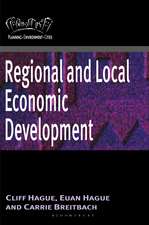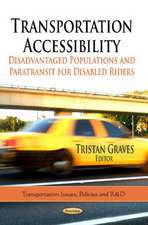Labor Forces and Landscape Management: Japanese Case Studies
Editat de Hiroyuki Shimizu, Chika Takatori, Nobuko Kawaguchien Limba Engleză Hardback – 29 noi 2016
This book consists of four main parts. The first part is concerned with forming concepts, definitions, and overviews. Change in land management policies, research topics, and issues on landscape management are dealt with in the second part. The third part consists of case studies on landscape management labor accounts. Major landscape types chosen for case studies include urban areas, flatland farmlands, Satoyama, and coastal neighborhoods. In the last part of this section, integration methods to develop landscape management labor accounts on different scales are considered. The fourth part of the book is a detailed exposition of contemporary trials to solve issues of land management for the future in the field of urban, rural, forest, river, and coastal planning. Also discussed is the connection of ecosystem service studies and perspectives on the development of landscape management labor accounts with world landscape management research.
| Toate formatele și edițiile | Preț | Express |
|---|---|---|
| Paperback (1) | 797.75 lei 38-45 zile | |
| Springer Nature Singapore – 4 iul 2018 | 797.75 lei 38-45 zile | |
| Hardback (1) | 820.37 lei 38-45 zile | |
| Springer Nature Singapore – 29 noi 2016 | 820.37 lei 38-45 zile |
Preț: 820.37 lei
Preț vechi: 1079.42 lei
-24% Nou
Puncte Express: 1231
Preț estimativ în valută:
156.98€ • 167.86$ • 130.88£
156.98€ • 167.86$ • 130.88£
Carte tipărită la comandă
Livrare economică 14-21 aprilie
Preluare comenzi: 021 569.72.76
Specificații
ISBN-13: 9789811022777
ISBN-10: 9811022771
Pagini: 374
Ilustrații: XV, 456 p. 268 illus., 236 illus. in color.
Dimensiuni: 155 x 235 x 29 mm
Greutate: 1.03 kg
Ediția:1st ed. 2017
Editura: Springer Nature Singapore
Colecția Springer
Locul publicării:Singapore, Singapore
ISBN-10: 9811022771
Pagini: 374
Ilustrații: XV, 456 p. 268 illus., 236 illus. in color.
Dimensiuni: 155 x 235 x 29 mm
Greutate: 1.03 kg
Ediția:1st ed. 2017
Editura: Springer Nature Singapore
Colecția Springer
Locul publicării:Singapore, Singapore
Cuprins
1. Landscape management labor account
1.1 Introduction: Back ground, concept and perspective on the research (Shimizu, Takatori)
1.2 Development of the concept and definitions
1.2.1 Landscape management labor accounts
1.2.2 Neighbourhood landscape complex units
1.2.3 Working style types
1.2.4 Importance of dealing with all kinds of landscape elements on a same level
1.2.5 Balance between biodiversity, productivity and labor efficiency
1.2.6 Integration from neighborhood landscape complex unit to national scale
1.3 Change in population, urban land use and basic landscape types
1.3.1 Overview of changes in population and urban land use
1.3.2 Estimated population changes between 2010 and 2050, and basic land scape types
1.3.3 Combined analysis between integrated categories of population and urban land use changes, and landscape types
1.4 What is happening in typical landscape types? (Previous studies on Land use and Landscape management)
1.4.1 Urban landscape type (Murayama, Kawaguchi)
1.4.2 Agricultural landscape type (Kawamura, Tsuchiya, Kawaguchi, Hagihara)
1.4.3 Urban and Satoyama forest landscape type (Terada)
1.4.4 Plantation forest landscape type (Yamamoto, Hirano, and Takatori)
1.4.5 Coastal area landscape type (Yamashita)
1.4.6 Water landscape type (Tashiro, Kitamura)
1.4.7 Geographical view point (Okamoto)
2 Case studies (Kawaguchi, Takatori and other)
2.1 Introduction-Application to Japanese case studies
2.2 Classification of neighbourhood landscape complex units
2.3 Calculation methodology of landscape labor accounts
2.3.1 Definition of indicators
2.3.2 Method of analysis 1. Case study on the neighborhood landscape complex units
2.3.3 Method of analysis 2. Integration of Landscape labor account
2.3.3.1 Data sets of landscape elements in Japan
2.3.3.2 Data sets of working style types in Japan
2.4 Case studies in urban neighborhood landscape complex unit
2.4.1 Park and Green Sites
2.4.1.1 Fujimaki Town (District with semi-nature greens)
2.4.1.2 Higashiyama Park
2.4.1.3 Shiratori Garden
2.4.2 Residential Area
2.4.2.1 Arako Town (District with rich private greens)
2.4.2.2 Central districts in Matsusaka City
2.4.2.3 The other Towns (Nagoya University, Golf Course) (Kawaguchi, Hayashi)
2.4.3 Conclusion
2.5 Case studies in Flatland farmland neighborhood landscape complex unit
2.5.1 Asami District (Flatland type)
2.5.2 Conclusion- The problems of sustainable landscape management
2.6 Case studies in Satoyama neighborhood landscape complex unit
2.6.1 Nyu District
2.6.2 Kayumi District
2.6.3 Forest Network
2.6.4 Conclusion- The problems of sustainable landscape management
2.7 Case studies in Coastal neighborhood landscape complex unit
2.7.1 Shima District
2.7.2 Conclusion- The problems of sustainable landscape management
2.8 Integration of Landscape labor accounts (Takatori and Shimizu)
2.8.1 Summary
2.8.2 Integration in a region scale (Case studies in Kushida River)
2.8.2.1 Population simulation in a region scale (Takano, Takatori) 2.8.3 Integration in a national scale
2.8.4 Issues on landscape management labor account in a demographic change- “Towards an affordable landscape labor account and management”
3 Detailed exposition (Land management policies, zonings, phenomena, social systems, measures, activities and perspectives)
3.1 Urban Planning (Murayama, Kawaguchi)
3.2 Green Planning (Terada)
3.3 Rural Planning (Tsuchiya, Hagihara)
3.4 Forest Planning (Yamamoto, Hirano)
3.5 River Planning (Kitamura, Tashiro)
3.6 Coastal Planning (Yamashita)
3.7 Connection to the Ecosystem service studies (Hayashi, Oba)
3.8 Community and Management (Kawamura)
3.9 Perspective of development of landscape management labor accounts from the viewpoint of world landscape management researches (Miyawaki)
Notă biografică
<Editors>
-Hiroyuki Shimizu, Professor, Graduate School of Environmental Studies, Nagoya University, Nagoya, Japan
-Chika Takatori, Assistant Professor, Graduate School of Environmental Studies, Nagoya University, Nagoya, Japan
<Authors>
-Hiroyuki Shimizu, Professor, Graduate School of Environmental Studies, Nagoya University, Nagoya, Japan
-Chika Takatori, Assistant Professor, Graduate School of Environmental Studies, Nagoya University, Nagoya, Japan
-Junich Kitamura, Research fellow, Graduate school of Bioresources, Mie University, Tsu, Japan
-Norio Kawamura, Associate Professor, Graduate School of Environmental Studies, Nagoya University, Nagoya, Japan
-Kazukiyo Yamamoto, Associate Professor, Graduate School of Life Agricultural Sciences, Nagoya University, Nagoya, Japan
-Akito Murayama, Associate Professor, Graduate School of Engineering, The University of Tokyo, Tokyo, Japan
-Kohei Okamoto, Professor, Graduate School of Environmental Studies, Nagoya University, Nagoya, Japan
-Kazu Hagihara, Associate Professor, The University of Shiga Prefecture, Hikone, Japan
-Nobuko Kawaguchi, Research assistant, Graduate School of Environmental Studies, Nagoya University, Nagoya, Japan
-Hiromi Yamashita, Associate Professor, College of Asia Pacific Studies, Beppu, Japan
-Toru Terada, Assistant Professor, Biosphere Information Science, The University of Tokyo, Tokyo, Japan
-Kazuaki Tsuchiya, Assistant Professor, Department of Ecosystem Studies, The University of Tokyo, Tokyo, Japan
-Yasuhiro Hirano, Associate Professor, Graduate School of Environmental Studies, Nagoya University, Nagoya, Japan
-Takashi Tashiro, Endowed chair associate professor, Disaster Mitigation Research Center Division, Nagoya University, Nagoya, Japan
-Masao Takano, Professor, Graduate School of Environmental Studies, Nagoya University, Nagoya, Japan
-Makoto Oba, Researcher, National Institute for Environmental Studies, Tsukuba, Japan
-Kiichiro Hayashi, Professor, Eco Topia Science Institute, Nagoya University, Japan
-Shigeya Nagayama, Researcher, Aqua Restoration Research Center, Kakamigahara, Japan
Textul de pe ultima copertă
The purpose of this book is to present a new proposal for landscape management labor accounts. Many matured countries are now confronting an aging society and a shrinking population. Land degradation in those countries is basically caused by a lack of local labor forces. It is very important, therefore, to consider and develop methods to provide appropriate labor forces for the sustainable management of landscapes or to reduce or shrink landscape management areas sustainably with available labor forces. Landscape management labor accounts provide a foundation for such development.
This book consists of four main parts. The first part is concerned with forming concepts, definitions, and overviews. Change in land management policies, research topics, and issues on landscape management are dealt with in the second part. The third part consists of case studies on landscape management labor accounts. Major landscape types chosen for case studies include urban areas, flatland farmlands, Satoyama, and coastal neighborhoods. In the last part of this section, integration methods to develop landscape management labor accounts on different scales are considered. The fourth part of the book is a detailed exposition of contemporary trials to solve issues of land management for the future in the field of urban, rural, forest, river, and coastal planning. Also discussed is the connection of ecosystem service studies and perspectives on the development of landscape management labor accounts with world landscape management research.
Caracteristici
Proposes a new concept of "landscape management labor accounts"
Presents case studies that provide a balance between theoretical development and actual evidence
Contains contributions by authors from various academic fields including urban planning, landscape planning, agriculture, forestry, sociology, and ecology
Includes supplementary material: sn.pub/extras
Presents case studies that provide a balance between theoretical development and actual evidence
Contains contributions by authors from various academic fields including urban planning, landscape planning, agriculture, forestry, sociology, and ecology
Includes supplementary material: sn.pub/extras














